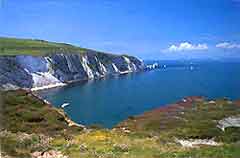Isle of Wight History Facts and Timeline
(Isle of Wight, Hampshire, England)

As the largest of England's islands, the Isle of Wight has a long and rich history. Not least, its English Channel location has made it particularly vulnerable to invasion.
It is known that the island's earliest inhabitants lived here from around 1900 BC. Known as the Beaker people because of the pottery they left behind, they called their home 'Wiht', which can be translated as 'what rises over the sea'. The Romans went on to call it 'Vectis'. Evidence of Roman life on the Isle of Wight includes the villa at Brading, which was once part of a wealthy farming estate.
Middle Ages
In the 11th century, William the Conqueror granted overlordship of the Isle of Wight to William FitzOsbern. It's at this time that Carisbrooke Castle was built. The castle has played a major role in the island's history ever since. Eventually, in 1293, ownership came into the hands of King Edward I, who paid 6,000 marks for the privilege.
The island's royal ownership was to be briefly interrupted during the 15th century when Henry de Beauchamp, 1st Duke of Warwick was crowned King of the Isle of Wight by King Henry VI. On Beauchamp's death, the regal title died too.
In the Middle Ages, the threat of attack was never far away. During the Hundred Years' War, the Isle of Wight was a prime target for the French. With only Carisbrooke Castle to defend the island, many of its towns were attacked, including Yarmouth, Newtown and Newport. The castle was continually modified during the 14th century.
From the Tudors to the Stuarts
By the reign of Henry VIII, the Isle of Wight had gained even greater strategic importance, with a new naval base being set up at nearby
Portsmouth. New fortifications were built at Yarmouth, East and West Cowes, and Sandown. In 1545, French attacks were successfully repulsed. However, the defeat of the Spanish Armada in 1588 did little to assuage fears that the Isle of Wight was vulnerable to future Spanish attack, and the island's defences were further strengthened.
The Isle of Wight achieved particular notoriety during the English Civil War, when the captured King Charles I was held prisoner at Carisbrooke Castle. He'd already made an escape attempt from Hampton Court in 1647, hence his removal to the Isle of Wight. After several unsuccessful attempts from Carisbrooke, the king was taken to Newport, before returning to
London for execution.
From the 19th Century to Modern Times
With the arrival of the railway age, the Isle of Wight suddenly became much more accessible. For Queen Victoria, that meant being able to spend more time at Osborne House, which she used first as a retreat and then as a royal residence. Her association with the island meant that fishing villages such as Ryde, Sandown, Shanklin and Ventnor soon metamorphosed into fashionable resorts, visited by European royalty. The Isle of Wight also became famous during this period for launching the world's first radio station, which Marconi set up on the western tip.
Even after Queen Victoria's death, the island's royal connection was maintained. Her youngest daughter Princess Beatrice became Governor in 1896 and continued to spend her summers at Carisbrooke Castle until her death in 1944. In 1965, Earl Mountbatten of Burma, great nephew to Princess Beatrice, took over the governorship, although there has been no governor of the Isle of Wight since his death in 1979.
 As the largest of England's islands, the Isle of Wight has a long and rich history. Not least, its English Channel location has made it particularly vulnerable to invasion.
As the largest of England's islands, the Isle of Wight has a long and rich history. Not least, its English Channel location has made it particularly vulnerable to invasion.